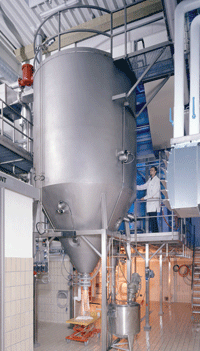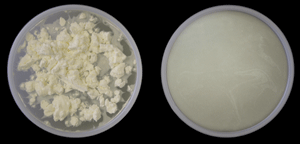The Essential Elements of Spray Drying
PROCESSING
Spray drying is a relatively simple and popular technology for converting liquids to dry powders. It has wide application in dairy and dairy-like products, such as coffee creamers, nonfat dried milk, dried whey, and other white ingredients. It also is used to produce soluble coffee and tea, fruit juice powders, and other ingredients. In particular, spray drying can be used to encapsulate oils and oil-soluble ingredients, such as vitamins.
Xin and Mujumdar (2010) give some useful equations for modeling some aspects of spray drying in a chapter within the book Innovation in Food Engineering. Here, we will provide some qualitative descriptions that might assist in selecting an appropriate process or in improving spray-drying operations.
The critical steps in spray drying include feed preparation, atomization, heating air, contacting air and liquid droplets, collecting dried powder, and controlling emissions. In addition, powders may need to be cooled, screened, agglomerated, further ground, and packed.
 Feed Preparation
Feed Preparation
Each feed may have unique steps involved in preparation. For example, coffee beans need to be roasted, ground, extracted with water, the extract possibly concentrated, and any additional ingredients mixed. Nondairy creamer (oddly named, as it is dairy-based) consists of nonfat dry milk, sugar, vegetable oil, and, possibly, other ingredients such as casein, whey solids, and emulsifiers. Dry nutritional powders (instant breakfasts) have similar formulas that must be assembled and sometimes heated to dissolve ingredients. Mixtures that contain oils need to be homogenized, often in a unit that also serves as a high pressure pump.
An obvious challenge in feed preparation is to involve as little water as possible while still dissolving all ingredients and not creating excessive viscosity. Viscosity is often proportional to solids content. Water, of course, is what is removed in drying and thus the consumer of energy. Viscous feeds can be difficult to atomize and require energy to pump.
Some feed mixtures benefit from aging before drying, while others can suffer segregation if not kept agitated. It is common to have surge vessels between feed preparation and the dryer so the dryer can be fed steadily, while feed preparation is often a successive batch operation. A common arrangement is a high shear mixer, such as a Breddo Likwifier, combined with a jacketed, agitated vessel so gums and emulsifiers can be dispersed and then added to bulk ingredients, such as syrups and oils. Water content should be monitored and controlled carefully since it is tempting to use water carelessly to chase transferred ingredients and to wash down walls of vessels. Variation in water content will cause variation in viscosity and variation in droplet size.
Atomization
There are several types of atomizers, all designed to generate a reasonably uniform dispersion of droplet sizes. Drying rate, and therefore drying time, is proportional to the radius of a particle squared. A given drying process, for a given feed only has a few variables to control once a specific dryer is chosen. Particle residence time is a function of particle radius, air flow rate, and the dimensions of the dryer. Very fine particles will over dry and may be lost in the product collection system. Larger particles may not dry sufficiently and, because they are partially wet, may stick to walls and other surfaces, reducing yield.
Some types of atomizers include rotating disks, pressure nozzles, pneumatic nozzles, and ultrasonic. Rotating disks or centrifugal atomizers introduce feed at the center of rapidly rotating disks that may have vanes to help direct the flow. A sheet of liquid is ejected from the edge and breaks up into droplets. Such an atomizer is especially good for feeds that contain entrained solids. Because of the motivation to minimize water content, some feeds may have undissolved solids, such as maltodextrins, used as carrier solids. Centrifugal atomizers may be more expensive than other choices.
Pressure nozzles have small orifices through which streams of feed are forced, which then break up into droplets. Pressure nozzles are inexpensive, but do have a tendency to plug, increasing back pressure and disrupting particle flow pattern.
Pneumatic nozzles mix compressed air, or an inert gas, with the feed liquid to assist in droplet formation. They are thus a bit more complex and also have a tendency to plug.
Ultrasonic nozzles use very rapid vibration to break up a stream of liquid into droplets. They may be limited in capacity.
It is common in large dryers to have multiple nozzles, each of which may need to have flow calibrated.
In at least one situation that I experienced, operators tried to maintain the highest pressure their pump could provide. This led to production of small droplets, some of which escaped the collection system and so reduced yield. I suggested backing off the feed pressure to increase particle size. This may be counterintuitive, but it could be applicable in other cases.
Heating Air
Air, or an inert gas, may be heated by direct combustion or indirectly by steam or electricity. Inert gas might be used when the solvent to be removed is other than water and might be flammable. It usually is prudent to recover such solvents as well. The heating medium—air or inert gas— may be introduced concurrently with the liquid feed or counter currently, at the bottom of the drying chamber, or in both locations. The resulting particle and air flow patterns may be complex. One objective is to prevent partially dried droplets from hitting side walls. This may require especially wide chambers. Better, if possible, is a tall chamber with precisely directed droplet flow.
Xin and Mujumdar provide suggested residence times of 10–20 seconds for fine, non-heat-sensitive products; 20–35 seconds for fine to coarse particles (approximately 180 μm); and greater than 35 seconds for larger particles (200–300 μm), low temperature.
--- PAGE BREAK ---
 Collecting Particles
Collecting Particles
Typically, air flow is directed from the bottom of the chamber either to a supplementary dryer or to cyclones. It is common to have a fluidized bed dryer after the spray dryer to finish drying the particles. Then air and dry particles pass through a cyclone, in which most of the product drops out for collection. Exhaust passes through bag filters, where more product is collected.
One proprietary design of a spray dryer has a fine mesh filter band at the bottom of the spray chamber. Particles collect on the belt, forming a mat which is further dried by passage of hot air through the belt. Relatively large chunks of solids fall off the belt, which are ground in a mill. The belt is washed and dried on its return passage. If particles are too small, they clog the belt and eventually cause a shutdown for thorough cleaning, which causes loss of production time and of the material stuck on walls and the belt. This is another case where control of particle size matters—smallest is not always best.
Volatiles Retention
Spray-dried products might be divided into those where flavor matters and those, such as white powders, where flavor is less critical. Products such as fruit juice powders, coffee, and tea have flavor components that are typically medium-sized organic compounds whose pure component vapor pressures are lower than that of water. However, in a thermodynamic paradox, such compounds, because they are in very dilute solution, have high activity coefficients and thus behave as if they are more volatile than water. This means, in practical terms, that they tend to be lost during drying. Typical soluble coffee and tea powders are brown particles with little flavor. (An additional reason is that extraction processes are focused on yield, which tends to decrease flavor.)
It may seem counterintuitive, but the way to maximize volatile retention in spray drying is to concentrate the feed so that flavor components are more concentrated and, oddly, less volatile as a result.
Low-Temperature Spray Drying
Zoom Essence is a flavor company in New Jersey that claims to offer superior flavors, encapsulated oils, soluble coffee, and active pharmaceutical ingredients using a low-temperature spray-drying process. Steve Hardek is Chief Financial Officer. Zoom Essence claims a proprietary process that is patent pending, so Hardek would not provide process details, but the company claims that its technology can produce large and high-density particles. Many spray-dried particles are porous because the water vapor expands as it is heated and can create fissures in the outer surface of droplets as they dry.
Hardek acknowledged that part of the Zoom Essence process involved using less water than usual. The company is interested in both selling what they believe are superior quality products (there are over 300 in their catalog) and in licensing their process technology to prospective partners.
Spray drying is a versatile process that is apparently still developing. Companies such as GEA Niro offer a wide range of commercial units, while others, such as Zoom Essence, are innovating.
 J. Peter Clark, Contributing Editor,
J. Peter Clark, Contributing Editor,
Consultant to the Process Industries,
Oak Park, Ill.
[email protected]
References
Xin, H.L. and Mujumdar, A.S. 2010. Spray Drying and Its Application in Food Processing, Chapter 9 in Innovation in Food Engineering, eds. M.L. Passos and C.P. Riberio, CRC Press, Boca Raton, Fla.
